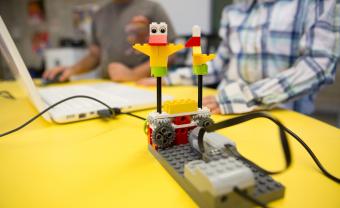STEAM approaches can help students learn skills relevant to the 21st century, including innovation and cultural sensitivity. A well-rounded approach to education also better enables teachers to use differentiated instruction to meet the needs of diverse learners.
STEAM’s Impact in the Classroom
As a result of the adoption of STEAM in classrooms across the country, new teaching methods have emerged. These approaches combine subjects and disciplines that have been separated from one another traditionally, says Maureen Creegan-Quinquis, a professor in Lesley University’s Graduate School of Education. And according to The Washington Post, STEAM promotes “skills seen as important in academic and life success.” Here are some of the skills the Post says students stand to gain from STEAM.
Creativity
Teaching students to think “outside of the box” causes them to approach tasks differently. They learn to be creative by using a wide variety of thought processes and skills throughout a classroom day.
Confidence
Approaches grounded in visual art, drama, and creative writing give students hands-on training in delivering a message and doing so with confidence. When combined with science, mathematics, and technology-based topics, students learn to tackle tough subjects with self-assurance.
Problem Solving
Learning new skills, whether technical or artistic, teaches students to approach new, potentially challenging situations with a positive attitude. Using STEAM, teachers can help students solve problems creatively using a variety of methods.
Collaboration
STEAM classrooms are highly collaborative, with students working together to grasp new information using multiple access points. They learn to share responsibility and compromise by working on group projects that incorporate multiple disciplines.
For Creegan-Quinquis, the effectiveness of STEAM is no surprise: “Science, technology, engineering, mathematics, and the arts all have very similar intellectual ancestors: some of the same philosophical underpinnings, some of the same inquiry questions. There’s always been a connection between the arts and these other domains … the difference is that now you will see deliberate as opposed to accidental cross-pollination between the subjects, and a lot of it is about making learning accessible.” She points out that one of STEAM’s central benefits is that it provides multiple access points, giving students with different learning styles and backgrounds ample opportunities to learn in the way that is best for them.



